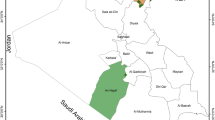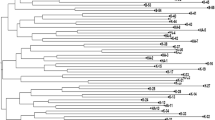Abstract
Weedy rice refers to populations of usually annual Oryza species that diminish farmer income through reduction of grain yield and lowered commodity value at harvest. The genetic diversity and population genetic structure of weedy rice in Liaoning Province were studied by RAPD and SSR markers. The results indicate that the level of genetic diversity of Liaoning weedy rice is very low, with polymorphic loci being only 3.70% (RAPDs) and 47.62% (SSRs). On the other hand, high genetic differentiation was found among populations, in particular between two regions (Shenyang and Dandong), with Fst values of 0.746 (RAPDs) and 0.656 (SSRs), suggesting that more than two thirds of the genetic variation resides among regions. Combined with our investigations of cultural traditions, the low level of genetic diversity in Liaoning Province is attributed to its narrow genetic background enhanced by exchanges of cultivar seeds, whereas the high genetic differentiation between the two regions is most likely the result of different founding parents and gene flow from local rice varieties to weedy rice. The rice cultivars in the two regions are all local varieties and are different genetically. A comparison of the two marker systems demonstrates that SSR is more informative and powerful in terms of the assessment of genetic variability, although both RAPD and SSR provide useful genetic information on weedy rice.
Similar content being viewed by others
References
Belaj, A., Satovic, Z., Gripriani, G., Baldoni, L., Testolin, R., Rallo, L., and Trujillo, I. (2003). Comparative study of the discriminating capacity of RAPD, AFLP and SSR markers and of their effectiveness in establishing genetic relationships in olive. Theor. Appl. Genet. 107:736–744.
Bres-Patry, C., Lorieux, M., Clement, G., Bangratz, M., and Ghesquiere, A. (2001). Heredity and genetic mapping of domestication-related traits in a temperate japonica weedy rice. Theor. Appl. Genet. 102:118–126.
Chen, L. J., Suh, H. S., and Lee, D. S. (2001). Evolutionary significance of Chinese weedy rice “Lu- Tao.” SABRAO J. Breed. Geneit. 33(2):99–109
Cho, Y. G., Blair, M. W., Panaud, O., and McCouch, S. R. (1995). Cloning and mapping of variety specific rice genomic DNA sequences amplified length fragment polymorphisms (AFLP) from silver-stained polyacrylamide gels. Genome 39:373–378.
Davierwala, A. P., Ramakrishna, W., Chowdari, V., Ranjekarl, P. K., and Gupta, V. S., (2001). Potential of (GATA)n microsatellites from rice for inter- and intraspecific variability studies. BMC Evolut. Biol. 1:7.
Davierwala, A. P., Chowdari, K. V., Kumar, S., Reddy, A. P. K., Ranjekar, P. K., and Gupta, V. S. (2000). Use of three different marker systems to estimate genetic diversity of Indian elite rice varieties. Genetica 108:269–284.
Excoffier, L. (1993). Analysis of molecular variance (AMOVA), Version 1.5. Genetics and Biometry Laboratory, University of Geneva.
Federici, M. T., Vaughan, D., Tomooka, N., Kaga, A., Wang, X. W., Doi, K., Francis, M., Zorrilla, G., and Saldain, N. (2001). Analysis of Uruguayan weedy rice genetic diversity using AFLP molecular markers. Electron. J. Biotechnol. 4(3) [online]. Available from http://www.ejbiotechnology.info/content/vol4/issue3/full/3/. ISSN 0717–3458.
Ge, S., Oliveira, G. C. X., Schaal, B. A., Gao, L. Z., and Hong, D. Y. (1999). RAPD variation within and between natural populations of the wild rice Oryza rufipogon from China and Brazil. Heredity 82:638–644.
Goudet, J. (2001). FSTAT: A program to estimate and test gene diversities and fixation indices (Version 2.9.3). From http://www.vnil.ch/izea/softwares/fstat.html.
Milbourne, D., Meyer, R., Bradshaw, J. E., Baird, E., Bonar, N., Provan, J., Powell, W., and Waugh, R. (1997). Comparison of PCR-based marker system for the analysis of genetic relationships in cultivated potato. Mol. Breed. 3:127–136.
Nei, M. (1978). Estimation of average heterozygosity and genetic distance from a small number of individuals. Genetics 89:583–590.
Oka, H. I. (1988). Origin of Cultivated rice, Japan Scientific Societies Press, Tokyo. 254 pp.
Page, R. D. M. (2001). Treeview 1.6.6. http://taxonomy.zoology.gla.ac.uk/rod/treeview.html.
Palombi, M. A., and Damiano, C. (2002). Comparison between RAPD and SSR molecular markers in detecting genetic variation in kiwifruit (Actinidia deliciosa A. Chev). Plant Cell Rep. 20:1061–1066.
Powell, W., Morgante, M., Andre, C., Hanafey, M., Vogel, J., Tingey, S. V., and Rafalski, A. (1996). Comparison of RFLP, RAPD, AFLP and SSR (microsatellites) markers for germplasm analysis. Mol. Breed. 2:225–238.
Qian, W., Ge, S., and Hong, D. Y. (2001). Genetic variation within and among populations of a wild rice Oryza granulata from China detected by RAPD and ISSR markers. Theor. Appl. Genet. 102:440–449.
Suh, H. S., Sato, Y. I., and Morishima, H. (1997). Genetic characterization of weedy rice (Oryza sativa L.) based on morphophysiology, isozymes and RAPD markers. Theor. Appl. Genet. 94:316–321.
Tautz, D. (1989). Hypervariability of simple sequence as a general source for polymorphic DNA markers. Nucl. Acids Res. 7:6463–6470.
Vaughan, K. L., Ottis, B. V., Prazak-Havey, A. M., Sneller, C., Chandler, J. M., and Park, W. D. (2001). Is all red rice found in commercial rice really Oryza sativa? Weed Sci. 49:468–476.
Watanabe, H., Vaughan, D. A., and Tomooka, N. (2000). Weedy rice complexes: Case studies from Malaysia, Vietnam, and Surinam. In Chin, D. V., Baker, B., and Mortimer, M. (eds.), Wild and Weedy Rice in Rice Ecosystems in Asia: A Review, International Rice Research Institute, Philippines, pp. 25–34.
Weir, B. S., and Cockerham, C. C. (1984). Estimating F-statistics for the analysis of population structure. Evolution 38:1358–1370.
Williams, J. G. K., Kubelik, A. R., Livak, K. J., Rafalski, J. A., and Tingey, S. V. (1990). DNA Polymorphism amplified by arbitrary primers are useful as genetic markers. Nucl. Acids Res. 18:6531–6535.
Yeh, F. C., Yang, R. C., Boyle, T. B. J., Ye, Z. H., and Mao, J. X. (1999). POPgene 3.2: The User-Friendly Shareware for Population Genetic Analysis. Molecular Biology and Biotechnology Center, University of Alberta, Edmonton.
Yu, L., and Nguyen, H. T. (1994). Genetic variation detected with RAPD markers among upland and lowland rice cultivars (Oryza sativa L.). Theor. Appl. Genet. 87:668–672.
Zhou, H. F., Xie, Z. W., and Ge, S. (2003). Microsatellite analysis of genetic diversity and population genetic structure of a wild rice (Oryza rufipogon Griff.) in China. Theor. Appl. Genet. 107:332–339.
Author information
Authors and Affiliations
Corresponding author
Rights and permissions
About this article
Cite this article
Yu, Gq., Bao, Y., Shi, Ch. et al. Genetic Diversity and Population Differentiation of Liaoning Weedy Rice Detected by RAPD and SSR Markers. Biochem Genet 43, 261–270 (2005). https://doi.org/10.1007/s10528-005-5218-3
Received:
Accepted:
Issue Date:
DOI: https://doi.org/10.1007/s10528-005-5218-3




